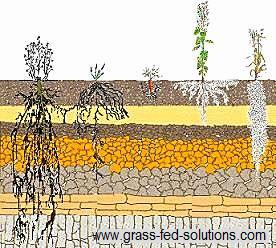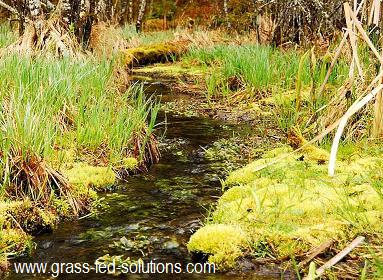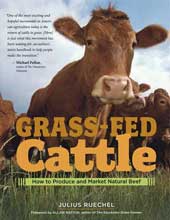Pasture Management with Electric Fences:
Soil Fertility, Riparian Areas
Part I Part II Part III Part IV
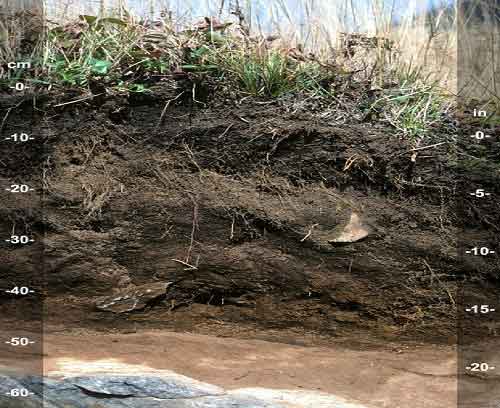
Image Credit: Soil Science
In Part I of this Pasture Management with Electric Fences article, I explained how you can use your electric fence grid and your daily pasture rotation to boost your pasture yields, improve the quality of your pasture grass, loosen compacted soils, and even reseed new plant varieties into your existing pasture mix.
On this page, Part II of this article, I will focus on your pasture soils. I will explain how to improve your soil fertility with your rotational grazing program. I will also discuss the pasture management strategies for areas with fragile or sensitive soils like riparian areas, flooded or muddy sections of pasture, or sections of reseeded pasture.
Improving Soil Fertility Using Your Pasture Rotation
When you use daily grazing slices in your pasture management, it ensures that cattle manure and cattle urine are distributed very evenly across each grazing slice rather than being concentrated in overused bedding areas or transported out of the pasture as cattle spend hours lounging in sites far-removed from where they were grazing. This means that the nutrients in the manure and the valuable nitrogen in the urine are returned back to the soil from where they came where they can immediately be broken down by the soil microbes and contribute both to the next burst of plant growth and to long-term soil building.
Daily pasture moves will therefore gradually improve your soil fertility over time, allowing you to offset some of your fertilizer requirements just through good grazing management. If you have a solid record of soil analysis over many years from your pastures, you will notice that as long as your pasture management strategy stays relatively consistent, then your fertilizer needs, especially nitrogen, phosphorus, and potassium, also tend to be fairly consistent. However, if you switch to daily pasture moves and do nothing else differently, you will notice that your fertilizer needs will gradually decrease simply as a result of how your cattle impact your pasture soils and how their manure and cattle urine are distributed in the pastures behind them.
Moving cattle less frequently, even every two days, will not have the same beneficial impact on your soil fertility. Daily pasture moves are essential to soil building and improving soil fertility.
Loosening compacted soils
As I explained in the Part I of this pasture management article, the daily pasture rotation also serves to loosen compacted soils and fractures the uppermost crust of soil. This, in turn, will allow moisture, earthworms, and other soil organisms to move freely through the soils. And that has a direct and very important impact on both your short-term soil fertility and your ability to use your grazing cattle for long-term soil building.
By using your grazing cattle to loosen your soils, plant roots will be able to reach further and deeper into the soil horizon to access nutrients. Deeper roots means more nutrients can be accessed that don't have to be delivered to your pastures on the back of a truck. And deeper, wider-reaching roots also means that the roots themselves will further aid to loosen soils and provide pathways to absorb and retain ground water.
Using daily pasture moves as part of your pasture management helps loosen the soil surface to allow for deeper and wider root penetration. Daily pasture moves also encourage greater plant variety in your pastures, which will draw nutrients from a wider range of soil horizons.
As I also explained in Part I, using a daily pasture rotation creates a pasture environment that lets many different plant species thrive simultaneously, in contrast to using longer grazing periods that will gradually eliminate the best plants through selective overgrazing while leaving only a handful of pasture grass species that are most resistant to continual or long-duration grazing periods. Greater plant variety has another important effect on soil fertility and soil building. Different plant species use different root systems (such as tap roots or fibrous roots) and draw nutrients from different levels in the soil horizon (ranging from shallow-rooted to very deep-rooted). By adopting daily pasture moves you create a pasture management system that supports a wide variety of plant species simultaneously in your pastures, which will all draw nutrients and moisture from different levels of the soil.
Daily pasture moves create a self-improving pasture ecosystem. Your cattle are more than just your end-product, they are also your primary pasture management tool. How you organize their grazing impact on your pastures makes all the difference to whether they gradually drain nutrients from the soils through the grass that they eat or whether their grazing impact translates into higher soil fertility in your pastures and reduces your need for expensive off-farm fertilizer amendments and on-farm manure composting operations. It just all happens naturally at the tail end of the cow, with the target effectively decided by where you put your portable electric fences each day during your daily pasture rotation.
You can find out more about the pasture management strategies used to improve soil fertility and manage soil nutrients in "The Great Herds and Their Grasslands", "Grass and Grazing", "Soil Fertility", and "Soil Moisture and Irrigation" chapters of Grass-Fed Cattle.
Pasture management in riparian areas
Pasture management in riparian areas like creeks, ponds, ditches, and other waterways usually means they are locked away behind permanent barb-wire fences to protect their fragile soils from grazing cattle. But exclusion is often nearly as harmful as giving cattle free access to these areas. Without grazing, pasture grass will slowly be replaced by other plant species that don't grow firm sod mats, which gradually de-stabilizes these waterlogged soils. Spring floods easily wash away the banks of these riparian areas. And among the plant species that take over the edges of these riparian areas will be countless weeds, which don't produce firm sod mats and which will gradually spread out to contaminate adjacent pastures.
Pasture management in riparian areas: graze alongside riparian areas during the dry season using temporary electric fences to direct grazing pressure. This helps eliminate weeds and stabilizes sensitive soils by creating a firm grass sod.
Portable electric fencing and your electric fence grid provide a much
simpler, more cost effective, and more beneficial pasture management
solution for the managing riparian areas alongside your pastures.
Use temporary portable electric fences connected to your electric fence grid to:
- Provide the required protection to prevent unrestricted cattle access to riparian areas during the wet season.
- Encourage the development of a stable sod mat (which prevents erosion) by moving the electric fence closer to the water's edge (or remove it altogether) during the dry season when soils are firm enough to support cattle.
- Give cattle some well-timed access to these riparian areas during the dry season so you can use grazing to reduce weed growth. Grazing keeps the grass competitive so weeds don't get a chance to take over the space at the water's edge.
- And it's much cheaper to manage your riparian areas with electric fences because you don't have to construct extremely expensive barb-wire fences that need constant maintenance. In fact, you don't need to construct a fence at all, you just put up the necessary bit of fence along the water's edge as your pasture rotation moves alongside - it essentially requires no extra effort beyond what you are already doing every day as you manage your daily pasture rotation.
Managing manure and limiting trampling-damage at the water's edge
Pasture management in riparian areas is about constantly striking the delicate balance between providing sufficient grazing pressure to promote sod formation and reduce weed growth without allowing the cattle to damage fragile soils or contaminate waterways with heavy manure concentrations. By restricting access to a small area for a few hours at a time (maximum 24 hours), you ensure that manure continues to be very evenly spread across the grazing area rather than building up in any favorite bedding area so that sunlight and natural decomposition processes can sterilize and break down the manure quickly. The short time spent grazing each slice of the riparian pastureland also reduces trampling damage to sensitive sod mats.
But cattle need to drink. Cattle will generally avoid muddy banks and extremely boggy soils if there is firmer ground with good grazing nearby, but thirst will drive them into the depths of the deepest swamps to find water. So managing your cattle's drinking water needs is the key to protecting those last fragile few feet of pond edge where the soils are most vulnerable to heavy cattle feet and where manure and water may actually come into contact with one another. The pasture management trick is to provide a convenient alternate water source so your cattle don't need to wade into the swamp to drink.
Place a livestock water trough in the pasture, on firm ground, immediately adjacent to the riparian area that your cattle are grazing. You can even draw water from the swamp itself to supply the trough using a hydraulic ramp pump, solar water pump, or stream-driven pump, which are discussed in detail in the "Livestock Water" chapter of Grass-Fed Cattle.
- Cattle are creatures of habit and will prefer to drink from the water trough if it is extremely convenient rather than from an unfamiliar water source.
- And cattle prefer to drink from water supplied on firm ground rather than wade into treacherous soft ground or muddy creek banks where they are unsure of their footing.
The key is to make sure that the trough is extremely convenient - if your cattle need to walk a long distance to reach it, they'll brave the swamp instead.
And the trough needs to be big enough, with a fast re-fill flow rate, so cattle don't need to wait around to get a drink, because they won't wait long for drink before they turn to the swamp instead.
It's not uncommon for all cattle tracks to end within a couple feet of a muddy creek, with the last few feet of swamp grass left un-grazed at the soft muddy creek's edge even without a fence to protect the creek if the cattle have access to a water trough a few feet further up the bank on firm ground and if you only allow access to the riparian area for a day or less at a time to prevent cattle from wading deeper into the swamp to search for un-grazed pastures. You also need to size grazing slices so there's a tall grass stubble left after grazing. If the cattle need to chew the grass right down to get their fill, they'll begin going after the less convenient grass at the swampy water's edge, even if they have to wade knee-deep through mud to reach it.
And avoid grazing riparian areas on extremely hot days (you can restrict access to the early morning on hot days) so the cattle don't turn to wallowing in the water to keep cool on hot afternoons.
As you can see from this discussion, pasture management in riparian areas depends of getting the cattle in - and out - of these sensitive riparian areas quickly and reducing their motivation to actually push the last few feet into the softest soils to reach the water's edge.
Flood control
Grazing flood channels is also an extremely efficient and effective flood control measure because grazing removes plant debris (without expensive mowers and high labor costs) so flood water can easily drain away instead of spilling over the banks because there was too much debris in the flood channel to allow the water to clear away quickly.
Managing e-coli risk in waterways
The primary concern most people have about letting cattle graze along riparian areas (other than damaging sensitive soils) is the risk of E-coli bacteria getting into the water source. The methods described below will dramatically reduce manure contact with the water.
- The daily pasture rotation ensures that manure is spread out thinly behind the cattle so sunlight, oxygen, and soil microbes can quickly break down the manure and destroy the bacteria.
- Only allowing the cattle access to a few hours of grazing in each section of a flood channel or watershed prevents manure concentrations from building up in select bedding areas where a lack of sunlight and oxygen would allow dangerous anaerobic bacteria to thrive and large concentrations of manure overwhelm the soil microbes ability to break down the manure.
- And providing drinking water in an adjacent trough reduces your cattle's motivation to wade into the water to drink.
But these pasture management methods can't eliminate contact altogether, nor will they prevent water contact with wildlife manure. The final measure of protection against e-coli contamination therefore has to come from the cattle themselves - from how their stomachs work. It has to be the same mechanism that protects us from e-coli when wildlife live in the riparian areas that we safeguard for their benefit.
It's therefore time to have a closer look at e-coli bacteria, which are present in the stomachs of ALL grazing animals, including the deer, moose, and antelope that live in the protection of these riparian areas. The short answer is that manure from grass-fed cattle poses no more risk to human health through e-coli contamination than manure from any wildlife that live in these riparian areas and drink from these waterways every single day. But manure from grain-fed cattle poses a very high risk of illness from e-coli if it gets into our drinking water. The difference between grass-fed and grain-fed cattle lies in what their diet does to the e-coli bacteria that live in the stomachs of all grazing animals.
All e-coli bacteria are not created equal. Our human stomach acids are extremely acidic, so only e-coli that have evolved to survive an acidic environment can harm us. E-coli that are accustomed to an environment with neutral acidity will be killed on contact with our highly acidic stomach acids.
E-coli bacteria live in the stomachs of all cattle (and all grazing wildlife), however, if the cattle are strictly grassfed, the acidity in their stomachs is virtually neutral. E-coli from a grass-fed cow's stomach has virtually no chance of surviving inside the acidic stomachs of a human so they are unlikely to pose any threat to us even if e-coli bacteria from a grass-fed animal are introduced into a water source that we drink from. It's the very same mechanism that keeps us safe from deer and moose manure that inevitably is deposited along all waterways.
However, the acidity in a cow's stomach increases dramatically when cattle are fed grains because an entirely different set of digestive microbes and digestive processes are required to digest grain. Thus, the e-coli that live inside the stomachs of grain-fed cattle are adapted to this highly acidic grain-digesting environment, which also allows them to survive inside humans if we come into contact with them.
So, from an e-coli risk management perspective, grass-fed cattle are ideally suited to grazing flood channels and managing other riparian areas that provide water for human consumption, while grain-fed cattle are best kept far away from waterways that are a source for human drinking water.
How to use electric fences to protect sensitive areas
There are lots of sensitive pasture areas with fragile soils, which require permanent sensitive grazing management strategies even if they are not classified as riparian areas. Most often these sensitive areas are simply temporary portions of your pastures, like freshly seeded areas, flooded or muddy patches, or simply a portion of a pasture that you want to save for later, such as a particularly thick stand of pasture that you want to save for winter grazing.
In a conventional pasture management program, the expensive permanent fence infrastructure does not lend itself to throwing up a temporary fence to protect muddy soils, a small reseeded winter-kill portion of a pasture, or a chunk or prime winter pasture in the middle of a large paddock. Conventional pasture fences simply don't offer the flexibility and cost-effective pasture management strategies to manage small areas separately. Either the entire pasture must be avoided, or more frequently, these sensitive areas are simply included in the pasture and suffer severe or even permanent damage because you couldn't restrict access to soils that were temporarily unable to sustain the impact of a grazing herd. Pasture grass yields suffer and costs mount to repair avoidable damage to pastures.
The temporary, cost-effective, and easily-portable nature of your portable electric fence subdivisions in your electric fence grid allow you to very easily manage even the smallest sections of pastures, either by throwing up a small bit of fence around an area that you temporarily want to exclude from your rotational grazing program, or simply by skipping ahead past the sensitive area during the pasture rotation, which requires no extra effort whatsoever on your part other than simply identifying which areas you don't want to graze.
Whether it's a reseeded area that could be reseeded immediately because of the protection of the electric fence grid, or a muddy or flooded area that could be easily excluded from the pasture rotation until the soils dry out a bit, these sensitive areas can get the special treatment they need so they can recover quickly and resume contributing to your pasture yields. Portable electric fencing allows you to temporarily protect even the smallest areas of your pastures so they don't become permanent holes in your pasture grass growth as a result of irreparable damage done by cattle feet during a vulnerable moment. Small areas add up quickly to make up a meaningful contribution to overall stocking rates and pasture yields. That's the beauty of using the smart electric fence grid for your pasture management - so simple, so cost effective, and so very, very flexible!
In Part III of this pasture management article, I will discuss how to use your electric fence grid and daily pasture rotation to improve your soil moisture, how to increase the drought-resistance of your pastures, and how to use your pasture rotation to reduce erosion problems.
Related Articles:
(Disclosure: I get commissions for purchases made using Amazon links in my post.) And when you're ready to start planning your cattle farm, check out my book: Grass-Fed Cattle: How to Produce and Market Natural Beef. Use the links below to explore my book and read reviews on Amazon: 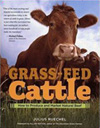
|

